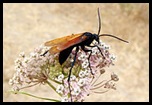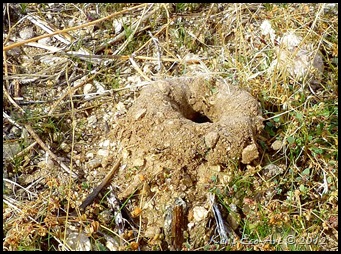| Notes: On 11/01/2012 , while hiking in the Spirit Mountain Wilderness Area, we came upon dozens of tarantulas (Fig. 01) slowly scurrying about the desert floor. Though someone suggested that the reason for these numerous sightings was because it was ‘mating season’, though I haven’t been able to find any information to support that theory. The pictures found in the polyptych (Fig. 02) below were actually taken at two different locations – the Spirit Mountain Wilderness Area and in the desert behind Walking Box Ranch off of Nipton Road, just outside of Searchlight, Nevada. Notice how the tarantula in the center is standing up on its hind legs in ‘attack’ mode. |
Description: There are 14 species of tarantulas in the genus, Aphonopelma. Tarantulas are the biggest and heaviest spiders by weight and have a body length of about 1 ½ inches with a leg span of three to five inches; they can stand up to three inches tall. Their sizes range from as small as a fingernail, too as big as a small dinner plate. They have four pairs of legs that connect to the fused head and thorax, are often hairy, and have two big fangs. Typically, the head-thorax region (cephalothorax) and legs are dark reddish brown, the abdomen brownish black; though some can be brightly colored. Male tarantulas are longer and slimmer than females with a smaller abdomen. They have eight marginally functional eyes in two groups on the forehead. There is a mouth and two backward-pointing fangs just below the eyes. There are two pedipalps (leg-like appendages) for food handling near the mouth. Their abdomen contains several vital organs as well as silk-producing spinnerets at the tip.
Tarantulas are slow and deliberate movers, but accomplished nocturnal predators. Insects such as crickets, June beetles, ground beetles, grasshoppers, cicadas, and caterpillars.are their main prey, but they also target bigger game, including frogs, toads, and mice. Tarantulas don't use a web to ensnare prey, though they may spin a trip wire to signal an alert when something approaches its burrow. They are burrowers that live in the ground. These spiders grab with their appendages, then use the "fangs" on the end of the chelicerae which injects poison when they bite prey. Because spiders only ingest liquid food they also secrete digestive enzymes to liquefy their victims' bodies so that they can suck them up through their straw-like mouth openings. Occasionally, they will chew the food somewhat while they feed. After a large meal, the tarantula may not need to eat for a month.
From what I can gather, evidence suggest that mating occurs during the spring. The mating ritual begins when the male spins a web and deposits sperm on its surface. He copulates by using his pedipalps (the short, leg-like appendages located near the mouth) and then scuttles away if he can — females sometimes eat their mates. The female then lays 100 to 1,000 eggs in the web which is constructed like a hammock. The egg sac is retained in the burrow, guarded, and usually held by the female. Eggs hatch in 45 to 60 days. Spiderlings hatch in July or later in the year within the egg sac. Once they leave the egg sac, the spiderlings may stay with the females for 3 to 6 days or longer before dispersing. Many of the young fall prey to other spiders or predators as they disperse to begin their own burrows.
Tarantulas have few natural enemies, but parasitic pepsis wasps, aka tarantula hawk (refer to Tarantula Hawk below) are a formidable exception. Such a wasp will paralyze a tarantula with its sting and lay its eggs on the spider's body. When the eggs hatch, wasp larvae gorge themselves on the still living tarantula. For some reason tarantula’s reputation isn’t that good. Maybe because they are big. Maybe because they are hairy. Maybe because they are poisonous. Well, yes, they are big, and hairy. They do have poison, but it can’t kill a person unless you’re allergic to it. For most people, tarantula bites are no worse than a bee sting.
|
 |
| (Fig. 03) |
 |
| (Fig. 04) |
Tarantula Hawk: The tarantula hawk (Fig. 03) is a spider wasp which hunts tarantulas as food for its larvae. Tarantula hawks belong to any of the many species in the genera Pepsis and Hemipepsis in the family Pompilidae (spider wasps). The more familiar species are up to 2 inches long, with blue-black bodies and bright, rust-colored wings, making them among the largest of wasps. The coloring on their wings warns potential predators that they are dangerous. Their long legs have hooked claws for grappling with their victims. The stinger of a female tarantula hawk can be up to 1/3 inch long, and the sting is considered among the most painful insect stings in the world. A female wasp will search the ground and tree trunks for a spider, and upon finding one, will sting it, paralyzing the spider. Once the spider is paralyzed, the female wasp will make a burrow or take the spider to a previously made burrow. She will lay one single egg on the abdomen of the spider and then enclose the spider in the burrow. The egg will hatch and the larva will feed on the spider. At the conclusion of the final instar stage, the larva will spin a silky cocoon, where it will emerge as an adult either later in the same summer season or will over winter, depending on the species and the time of year the larva pupates. We observed several of these large wasps flying around the area. We also found this well build burrow which we thought might be an underground wasp nest. |